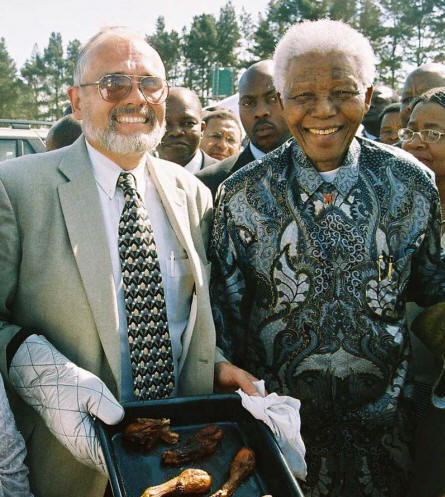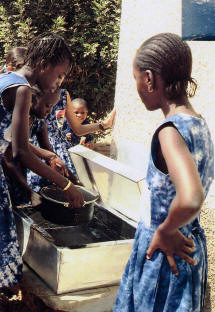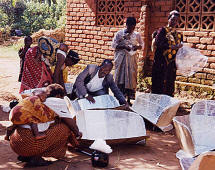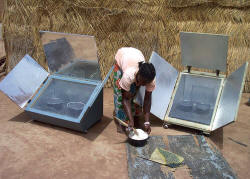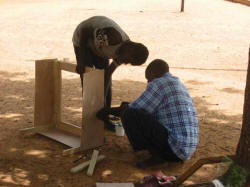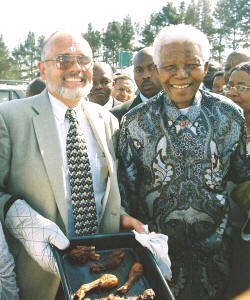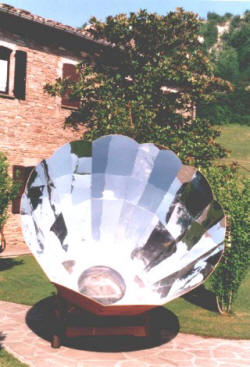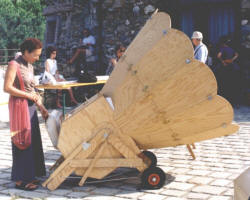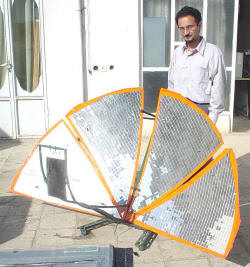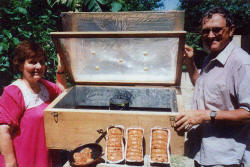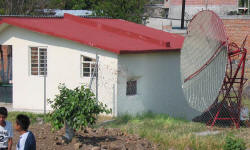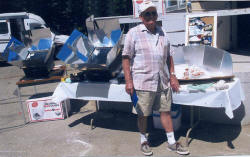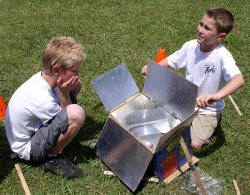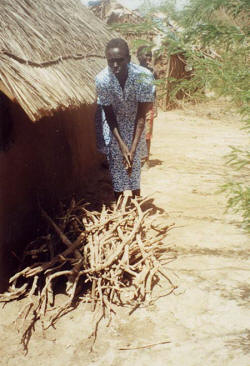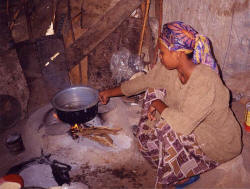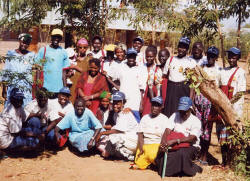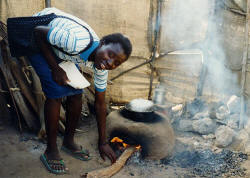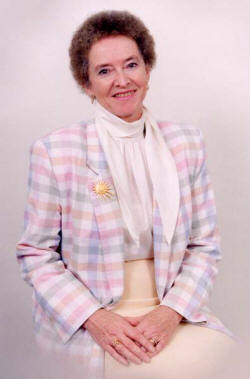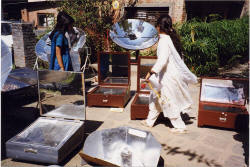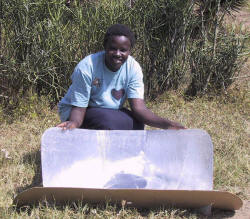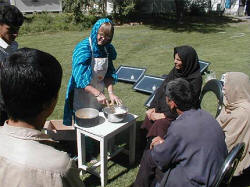| Solar Cookers International... 1919 21st Street, #101 Sacramento, CA 95811 USA Tel. 916-455-4499 Fax 916-455-4498 E-mail: info |
Solar Cooker Review November 2004 |
Solar Cooking
Archive: |
|
Volume 10, Number 2 |
| |
Editor's note: "News you send" is compiled by Ramón Coyle, SCI's
information exchange specialist. E-mail your news items to ramon![]() solarcookers.org
or mail to Ramón Coyle, Solar Cookers International, 1919 21st Street #101,
Sacramento, California 95811-6827, USA. Please include your contact information.
All submissions are subject to editing.
solarcookers.org
or mail to Ramón Coyle, Solar Cookers International, 1919 21st Street #101,
Sacramento, California 95811-6827, USA. Please include your contact information.
All submissions are subject to editing.
WORLDWIDE
It has come to our attention that some readers of the Solar Cooker Review send donations directly to the organizations described in these pages. One recipient organization, EMACE of Sri Lanka, sent a reminder that it is wise to check with the organization before donating to ask the best way to transfer funds. In some cases, the cost of converting money from abroad consumes most of the donation unless the method of transfer is carefully chosen.
AFRICA
The Gambia
Mr. Saikou Jarra reports that the Tubanding Earth Savers Association sponsored solar cooking and solar energy demonstrations for over 1,000 people at a weeklong celebration of women held in August. The Association solar cooked Mbahal in 2 ½ hours and ground nut porridge in 1 ½ hours. Women observing the demonstrations said the time saved with solar cooking would allow them more time in their farms, gardens and rice fields to generate more income. Mr. Jarra said demand would be very high for solar cookers, but his organization is under severe financial constraints and is unable to meet the demand. Contact Mr. S. Jarra, Tubanding Village, Bansang Post Office, Upper Fulladu West District, Central River Division, The Gambia
Ms. Rosalyn Rappaport spent a few weeks at the Marina International School introducing solar cookers to the students and administrators. She worked with students to, among other things, construct simple solar cookers based on Solar Cookers International's "CooKit," test cooking temperatures and graph results, and analyze scientific and culinary aspects of solar cooking. Solar-cooked dishes included fish stew, wonjo (a tisane of hibiscus flowers), ebbeh (smoked fish with cassava), chicken yassa (chicken stew with onions and lemon), and bread. The school's head of design and technology―Mr. Stafford―indicated to Ms. Rappaport that he thinks solar cookers would make a good subject for the General Certificate of Secondary Education (GCSE) exams. She is enthusiastic about the idea. Ms. Rappaport plans to write a solar cooking booklet using West Africa dishes either cooked at the school or suggested by the students and cooked by others. Mr. Stafford has agreed to help her write the science chapters. Contact Ms. R. Rappaport, 31 Lodge Lane, London N12 8JG, United Kingdom. Tel: 0181-446 3690
Students at Marina International School learn to bake bread with a simple, effective solar box cooker
Malawi
The solar cooker project headed by Mr. Hosana Nyirenda and funded by the Lilongwe Rotary Club trained 30 women in the central region of Malawi to make and use CooKit-type panel cookers. Ten women have been provided CooKits that they did not make themselves, to compare their future usage with women who make their own cookers. The project hopes to expand to the northern and southern regions and potential partners are being contacted in those areas. Mr. Nyirenda also seeks correspondence from and information exchange with other solar cooking promoters in Africa and beyond. Contact Mr. H. Nyirenda, PO Box 7, Mchinji, Malawi
Mr. J.K. Kaunda demonstrates CooKits to women in the Chinsapo peri-urban area of Lilongwe
Mali
Mr. Gnibouwa Diassana of Bla wrote to say that he has recently celebrated his 10th anniversary as a builder of a wide variety of solar cookers. "It has not been so easy, but PATIENCE is a golden way," he says. In May 2004, with support from the University of Turin in Italy, Mr. Diassana held trainings and distributed cookers to women's associations in Bamako. Contact Mr. G. Diassana, BP 26, Bla, Mali. E-mail: gnibouwa_diassana@wvi.org
Mali women are learning to prepare tô―a porridge-like food staple in Mali made from millet, sorghum or corn flour and served with a sauce of meat or vegetables―in solar cookers
Mauritania/Senegal
Braving various road hazards on a long trip through tragically deforested landscapes, Mr. Abdoulaye Toure, known in Senegal as "Mr. Sun," and president of Senegal's Amis du Soleil, led a solar cooking training for Peace Corps volunteers in Kaédi, Mauritania, in August. Working with the Corp's small and medium business program's training coordinator, Racey Bingham, Mr. Toure and the trainees built a solar box cooker from a used beverage case, aluminum foil and two layers of glass, and tested it. The group then moved to the shade of a tree to discuss the relationships between fuel wood shortages, deforestation, erosion, air pollution, climate change, poverty reduction and solar cooking. Solar Cookers International's cardboard panel cooker, the "CooKit," and the "HotPot"―the special pot and insulating bowl promoted by Solar Household Energy (SHE)―were demonstrated to the trainees. The following day, the trainees enjoyed solar-cooked Ratatouille a la Mauritanienne. Mr. Toure is a SHE representative in West Africa. Contact Mr. A. Toure, Amis du Soleil, Quartier Ndiop, Mékhé, Senegal. E-mail: pcsatoure@yahoo.fr
Peace Corps volunteers built solar box cookers from used beverage cases, aluminum foil and glass
South Africa
In June 2004, Sun Ovens International―a solar cooker manufacturer and promoter based in Elburn, Illinois, USA―received an innovation award from the World Bank to establish a solar-powered bakery in South Africa to employ HIV-positive women and serve nutritionally fortified bread. The bakery opened recently in Eastern Cape, South Africa. Foods are baked in a Villager Sun Oven(r) that reaches temperatures in excess of 250°C and can bake hundreds of loaves of bread each day. With the included propane backup system the oven can operate nonstop, rain or shine. Former South Africa president Dr. Nelson Mandela attended the bakery dedication. Contact Sun Ovens International, 39W835 Midan Drive, Elburn, Illinois 60119, USA. Tel: (630) 208-7273, fax: (630) 208-7386, e-mail: info@sunoven.com, Web: http://www.sunoven.com
Dr. Mandela (right) looks on as Sun Ovens International President Mr. Paul Munsen holds a pan of solar-cooked chicken
Uganda
Golooba Lawrence reports teaching more than 400 people about solar cooking in and around the village of Kkungu in Gombe sub-county, adding "We have used cookers for baking (especially cakes) and for cooking food like rice, Irish potatoes, and cassava. This year I started introducing this program of solar cooking to women's clubs. So far, three clubs have benefited ... and in June this year I started the same program in nearby schools." Contact G. Lawrence, c/o Batenga Mary Bernadett, Uganda Seed Project, PO Box 7065, Kampala, Uganda
EUROPE
Germany
An organization called Sun Ovens for Europe has been operating for five years with the purpose of supplying the European market with solar cooker information and products. They work with a number of European partners, including Heike Hoedt and Mr. Wolfgang Scheffler, the inventor of the Scheffler solar community kitchens. Spokesperson Mr. Cornelius Tribbeck writes that, while Sun Ovens for Europe has sold many products, "we believe that what really counts is the number actually being used on a daily basis." Contact: Sun Ovens for Europe, c/o Cornelius Tribbeck, Dreimuehlenstr. 24/R, D-80469 Munich, Germany. E-mail: info@sunoven.de, Web: http://www.sunoven.de
Italy
Mr. Gianni Crovatto has created an interesting solar cooker Web site in the Italian language. It gives instructions in Italian for building several types of solar cookers. His designs range from simple, lower temperature cookers to complex, powerful cookers capable of reaching very high temperatures. Some of Mr. Crovatto's unique designs incorporate elements of both parabolic cookers and solar box cookers. Large, metal reflectors collect light from a wide area and focus it on the window of a heavy-duty box cooker. The Web site is found at http://digilander.iol.it/giannicrovatto
One of Mr. Crovatto's powerful solar cookers as seen from the front...
...and from the side, where this solar cook is seen checking on the food through the rear access door.
Switzerland
Naim Janmohamed, who hails from Nanyuki, Kenya, reports using a panel-style solar CooKit while visiting Switzerland. "I cooked vegetables, potatoes, ugali and made bread everyday! It was wonderful. We put the bread on the fire for two minutes just to get a crust, but otherwise it was already cooked." Naim is working on plans for a public demonstration of solar cooking in Nanyuki. Contact N. Janmohamed by e-mail: naim.janmohamed@gmx.ch

Before baking, Mr. Janmohamed placed dough balls in two black pots in the CooKit, then covered the pots and enclosed them in a transparent, heat-resistant plastic bag.
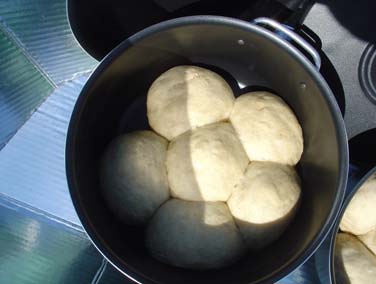 ]
]
The final product: five beautifully-risen bread rolls.
ASIA/PACIFIC
India
The Rishi Valley School reports that they have a community solar cooking system that cooks 500 meals per day. The system includes 10 parabolic dishes that produce steam used to cook the food. Contact Rishi Valley School, Rishi Valley, Chittor District, Andhra Pradesh - 517 352, India
Iran
Mr. Amir Mahdi Komarizadeh of Tehran hosted a few rounds of international information exchange this year as he received solar cooking visitors from the USA and Costa Rica. Mr. Komarizadeh is a university student with a strong interest in solar energy. He has built a solar still and has designed and built an original semi-parabolic solar cooker. His university thesis investigates the design for a single system to provide solar heat for cooking, space heating, water heating and other functions, based on the idea of focusing sunlight on a heat storage and distribution fluid. One of his international guests was Dr. Shyam Nandwani, a world leader in solar cooker development and former Solar Cookers International (SCI) board member. Dr. Nandwani, who is Indian by birth, is a longtime resident of Costa Rica where he heads the solar section of the physics department at the Universidad Nacional. Mr. Komarizadeh used his solar cooker to prepare baked fish, baked apples and tea for Dr. Nandwani, and the two discussed designs of cookers, stills and dryers. Dr. Nandwani, who describes Mr. Komarizadeh as a "hard-working boy," predicts that building the multi-use solar heating system will be a tremendous learning experience for the university student. Mr. Komarizadeh also met with Dr. Mahnaz Saremi and Dr. Said Shakerin, both Iranian by birth, long-time U.S. residents, and among SCI's founders. Dr. Saremi reports that Mr. Komarizadeh's semi-parabolic cooker has two novel features. First, it has a focal line instead of a focal point, which reduces the chance of burning the food. Second, should food be spilled from the cooking pot, it will not fall on the mirrors because of the cooker's design. Mr. Komarizadeh reports that he has made some panel-style solar cookers ("CooKits") and uses them to make tea, and he has demonstrated SCI's Water Pasteurization Indicators (WAPIs) given to him by Dr. Nandwani at exhibitions in Iran. Contact Mr. A. Komarizadeh by e-mail: faratab@yahoo.com
Mr. Komarizadeh and his semi-parabolic cooker
Philippines
Don and Margaret Messerer report that they will soon be returning to the Philippines and will continue to lead solar cooking classes and demonstrations there as they have done in the past. Contact Mr. D. Messerer, PO Box 269, Rock Creek, Minnesota 55067, USA
Oat bread and cinnamon rolls bake up nicely in the Messerers' solar box cooker
Uzbekistan
Mr. Ken Hargesheimer taught solar box cooker construction during a gardening workshop he conducted in Nukus, Uzbekistan. He then solar cooked rice for the participants. The gardening workshop was sponsored by Perzent, a nongovernmental organization (NGO) in Uzbekistan. Contact Mr. K. Hargesheimer by e-mail: Minifarms@aol.com
THE AMERICAS
Argentina
Solar cooking was featured in El Día newspaper in Gualeguaychú, Entre Ríos province. Mr. Adolfo Larran―a solar cook and solar cooking promoter―is inspired by his mother, Mrs. Laura Garat de Larran, who lives in Salta, Argentina, and who was also featured in the newspaper article. Mr. Larran told the newspaper, "Since 1997, there is in Salta a complete solar movement and there are entire towns that live thanks to solar energy, because piped gas doesn't reach them and bottled gas is too expensive. The families heat water and make their meals [with solar energy]." Mr. Larran gave solar cooking presentations to the local director of social development and to members of the nongovernmental organization (NGO) Caritas in Gualeguaychú. Contact Mr. A. Larran by e-mail: alarran@entrerios.net
Jujuy was the site of a weeklong series of working meetings uniting solar promoters from both Argentina and Paraguay. Topics covered included creation of solar teams, development of micro-enterprises based on solar energy, solar heating for schools, and solar pumps. The central theme was creation of the first Argentine "solar village" in Misa Rumi at 3,710 meters above sea level in the Andes Mountains. The Center for Solar Energy of Paraguay (CEDESOL) reported on Paraguay's first solar village, Bahía Negra, including thoughts on how solar dryers can aid in micro-enterprises involving medicinal plants and sun-dried fruits. Among those representing CEDESOL were its president, Dr. Martin Almada, and engineer Mr. Jean-Claude Pulfer, a longtime associate of the Swiss solar cooking organization Group ULOG. Argentina's delegation included members of two foundations―Ecolandia and Pirca―that promote solar cooking in small communities in the Andes. The meetings also included consideration of extending activities into Bolivia's Andean regions. Contact Dr. M. Almada by e-mail: almada@rieder.net.py
Mr. Jorge Soler reports that a small nongovernmental organization (NGO) has been formed in the municipality of San Martín in Buenos Aires province that serves "cartoneros." Cartoneros, derived from the word "carton" (cardboard) is a term used in Argentina to describe the growing number of people who have lost jobs in the last few years of economic crisis and who roam the streets of the towns looking for discarded items that might be collected and sold for enough money to survive. (Compiler's note - in California, USA our "cartoneros" survive mostly by collecting discarded glass bottles and aluminum cans.) Mr. Soler, along with another volunteer and a number of cartoneros, has set up a service cooperative called "El Orejano," where courses are given on building solar cookers. The group is also developing information on low-cost but nutritious foods to share with the cartoneros and low-income mothers and children. Contact El Orejano by e-mail: porunavidadigna@argentina.com
Costa Rica
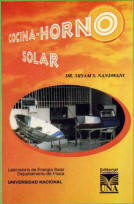 "Renewable Energy for the Developing World," an annual workshop led by Solar
Energy International, will be held this coming year at Rancho Mastatal
environmental learning and sustainable living center. The center is located in
the last virgin rainforest of Costa Rica's Puriscal County. The property shares
a significant border with the splendid La Cangreja national park.
The seven-day workshop, which begins on March 7, 2005, will include classroom
sessions and labs, and will have a strong hands-on component. The workshop will
focus on three main topics: solar cooking, methane digesters, and an additional
topic to be determined. There will also be survey coverage of other solar, wind
and hydroelectric systems, and social and cultural issues surrounding renewable
energy in the developing world. The workshop fee is $650. Contact Solar Energy International, PO Box 715, 76 South 2nd Street, Carbondale,
Colorado 81623, USA. Tel: (970) 963-8855, fax: (970) 963-8866, e-mail:
sei@solarenergy.org,
Web: http://www.solarenergy.org
"Renewable Energy for the Developing World," an annual workshop led by Solar
Energy International, will be held this coming year at Rancho Mastatal
environmental learning and sustainable living center. The center is located in
the last virgin rainforest of Costa Rica's Puriscal County. The property shares
a significant border with the splendid La Cangreja national park.
The seven-day workshop, which begins on March 7, 2005, will include classroom
sessions and labs, and will have a strong hands-on component. The workshop will
focus on three main topics: solar cooking, methane digesters, and an additional
topic to be determined. There will also be survey coverage of other solar, wind
and hydroelectric systems, and social and cultural issues surrounding renewable
energy in the developing world. The workshop fee is $650. Contact Solar Energy International, PO Box 715, 76 South 2nd Street, Carbondale,
Colorado 81623, USA. Tel: (970) 963-8855, fax: (970) 963-8866, e-mail:
sei@solarenergy.org,
Web: http://www.solarenergy.org
Dr. Shyam S. Nandwani, a world leader in solar cooker development and former Solar Cookers International board member, has released an updated version of his book "La Cocina / Horno Solar." Contents include descriptions of various solar cooker types, solar box cooker construction plans, cooking times for a number of foods, advantages and limitations of solar cooking, and an array of experimental data. Dr. Nandwani heads the solar section of the physics department at the Universidad Nacional. Contact Dr. Nandwani, Laboratorio de Energía Solar, Departamento de Física, Universidad Nacional, 3000 - Heredia, Costa Rica. E-mail: snandwan@una.ac.cr
Mexico
Another solar cooking organization has been identified in Mexico. Grupo Scheffler de Mexico is introducing solar ovens, Scheffler solar community kitchens and other solar products. They offer training, manufacturing, sales, live shows and conferences. More information is available on these Web pages: http://www.sunoven.de/presentation-Folien1.html and http://www.sunoven.de/Scheffler-Jiutepec.html
This Scheffler solar community kitchen―the first of its type in Mexico―feeds over 150 students at Matutina Juana de Asbaje primary school in Jiutepec, Morelos
Paraguay
Thanks to cooperation from Spain's Polytechnic University of Catalonia, a "solar workshop classroom" has been created at the headquarters of the Celestina Pérez de Almada Foundation to educate the public about solar energy. The University sent engineer Mr. Juan Morey to create instructional materials, documentation and workshop prototypes, including solar water pumps, solar fans, solar water heaters, solar cookers, and solar food dryers. Contact Dr. M. Almada of the Almada Foundation by e-mail: almada@rieder.net.py
USA
Mr. Ken Farnsworth of Idaho demonstrated solar cookers during ecology week at the Boise Discovery Center. His demonstrations were featured on local television in Boise. Contact Mr. K. Farnsworth, 138 Willoway Drive, Boise, Idaho 83705, USA
Mr. Farnsworth and his solar cookers
Sacramento, California teacher Ms. Suzette Delbono reports that her colleague, 6th grade teacher Ms. Missy Smith-Benke, has involved students at Oakview Community Elementary School in designing their own solar cookers. Ms. Delbono says that the children's designs were very creative, including one solar cooker made from a black trashcan and another shaped like a cat carrier. Ms. Delbono incorporates solar cooking lessons in her classroom, and has developed a solar cooking "WebQuest" found on the Internet at https://home.comcast.net/~sdelbono/solar/newpage1.htm. (WebQuests are inquiry-oriented activities designed to help students become efficient and effective Internet researchers by encouraging analysis, synthesis and evaluation.
Oakview students experimented with several creative solar cooker designs, including this one with a Fresnel-type lens
Holly and Bert Davis write in the September 2004 issue of their zine Dwelling Portably about how solar and flame cooking differ. "With flame, heat comes from below, so the food cooks from bottom up. ... With our [panel-style solar cooker] heating is usually greatest on top where both direct and reflected rays shine, whereas the bottom gets only reflected rays. The lower the sun, the less the difference, because fewer rays shine on top and more reflect onto the bottom. Also, the higher the pan [is raised on a transparent or mesh stand], the less the difference, because more space between bottom-center reflector and pan lets in more rays." Contact Dwelling Portably, PO Box 190-L, Philomath, Oregon 97370-0190, USA
A new solar cooking club recently formed in San Antonio, Texas, according to one of its founders, Dr. Monica Gutierrez Salyer. The first meeting involved solar cooking salmon in a box oven and experimenting with the power of a focusing cooker. Dr. Salyer has experimented with Texas cuisine and reports that the "three most popular meats in Texas―brisket, ribs and fajitas―can be solar cooked, and they will turn out at least as good as anything cooked in a pit, with a lot less work." She says that Solar Cookers International's "humble CooKit" does a great job of holding the desired low temperatures (under 120ºC) for an extended period of time. In cooking brisket, Dr. Salyer uses an eight-pound, enamel-clad, cast-iron casserole dish, proving that in the Texas sun, the CooKit can handle a large thermal mass. Meanwhile, the San Antonio group has moved forward with two more solar cooking demonstrations in September - one at a San Antonio super market and one at an "energy roundup" event in Fredericksburg. Contact Dr. M.G. Salyer by e-mail: omei_shan_phnx@yahoo.com
Note from the compiler: Dr. Salyer represents a clear example of a standard solar cooker promotion model. First, she developed her expertise by use and experimentation with solar cookers and favorite recipes. Second, she shared the solar cooking idea with others - with family, friends and neighbors, and in public settings. Third, when she finds interested people, she helps them learn. Fourth, with other avid solar cooks, she joins forces to form an organization to promote wider spread. Fifth, she communicates with other solar cooking promoters worldwide - through her membership in Solar Cookers International (SCI), through her listing in SCI's International Directory of Solar Cooking Promoters (on the Internet at http://solarcooking.org/directory.asp) and through SCI's solar cooking e-mail discussion group (on the Internet at http://solarcooking.org/solar-l.htm).
Final Kakuma evaluation: solar cookers filled a critical gap
By Kevin Porter, SCI Education Resources Director
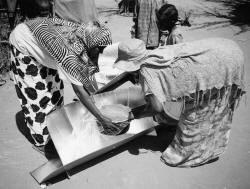 The following summarizes an independent study by Nairobi-based Center for
Independent Research. The study was commissioned to review Solar Cookers
International's entire solar cooker project in Kakuma refugee camp in
anticipation of SCI's phase out and eventual replacement by a refugee owned and
operated cooperative. The evaluation took place in 2003, eight years after the
project started and one year after free distribution of solar cookers and black
pots transitioned to a sales-based program in the camp.
The following summarizes an independent study by Nairobi-based Center for
Independent Research. The study was commissioned to review Solar Cookers
International's entire solar cooker project in Kakuma refugee camp in
anticipation of SCI's phase out and eventual replacement by a refugee owned and
operated cooperative. The evaluation took place in 2003, eight years after the
project started and one year after free distribution of solar cookers and black
pots transitioned to a sales-based program in the camp.
SCI's first field project―and its largest to date―began in January 1995 in Kakuma refugee camp in northwestern Kenya, then housing 28,000 refugees, primarily Sudanese and Somali, but also people from Ethiopia, Congo, Burundi, Eritrea, Rwanda and Uganda. The project started as a field test the determine the usefulness of SCI's simple, new panel-style solar cooker (the "CooKit") among these refugee families of various cultures. The CooKit proved useful, and SCI was urged to expand to additional refugee camps.
Kakuma―a camp with high refugee turnover―grew to nearly triple its original size during SCI's eight-year presence. By SCI's own estimates it ultimately empowered 15,000 families in the camp to solar cook.
Solar cookers make sense in this remote, sunny, arid camp where fuel gathering outside the camp is forbidden and firewood rations are usually only about one-third of what is needed to cook the food rations. The study documented the costs of purchasing cooking fuel from local, nomadic Turkana people. Often the only "money" refugees had was a portion of their sparse food rations to barter for essential fuel to cook the rest.
Firewood rations range from insufficient to none
Cookers were lost in floods, and occasionally stolen, but at the time of the study 20% of the camp residents reported using solar cookers, half of them nearly every day. In the Kakuma 1―the area of the camp where SCI's promotion was concentrated―preference for solar cooking was second only to the charcoal-fueled All-Metal Stove (AMS). Ninety percent of all camp residents knew about solar cookers.
Refugee-defined benefits
Refugees identified many solar cooking benefits.
Saving money was a primary benefit. Families that solar cook whenever possible could save up to 510 Kenyan shillings (nearly $7) per month, or over 50% of their monthly fuel expenditure. In addition, families that barter food for fuel could save over 20 kilograms of grains monthly. The solar CooKit was rated as much better than the traditional three-stone cooker, the AMS and the paraffin stove in reducing expenses.
Solar cooking is more economical than traditional wood-fueled cooking, shown here.
Another identified benefit was a positive change in lifestyle. "Among the women that use solar cookers regularly, the implements have occasioned a dramatic change in daily routines such as seeking firewood from the market, thereby releasing time for other engagements." Gender roles in domestic chores changed somewhat as well. "Whereas Sudanese men would ordinarily not cook due to stereotypes, they comfortably cook using solar CooKits, which are generally not regarded in the same way as fire-based cooking devices."
Disabled and vulnerable individuals appreciated the cost savings and reduced physical burdens associated with solar cooking. However, some of them indicated that they were not solar cooking due to the inability to afford the initial cooker cost.
Refugees also praised solar water pasteurization. "Use of solar CooKits for water pasteurization ... contributed to the reduction of the incidences of waterborne diseases."
Other noted benefits included increased safety for children (as opposed to dangerous cooking fires) and the ability to let food cook for extended periods of time, while other activities are carried out, without the risk of food burning.
Other positive outcomes
The evaluation found that SCI's solar cooking program complements other energy programs in the camp. "The solar cooking project has integrated quite well with the other energy utilization projects in the camp. Whereas the use of the solar CooKit, in and of itself, is not regarded as the panacea to the energy problem in the camp, it is yet highly appreciated as a source of energy complementing the other energy sources."
Aspects of SCI's project design and implementation were also seen as favorable. For instance, the creation of job opportunities within the camp was viewed in a very positive light. "The project has provided employment opportunities in a set up that is characterized by general hopelessness and idleness. There were a total of over 40 job opportunities created directly, and over 50 others indirectly. No doubt the incomes from such employment have had positive welfare consequences for households of the employed." Evaluators particularly commended SCI's use of refugees as trainers, stating that this "gives the project some innate life that keeps it alive and fosters the target community's identification with, and ownership of, the project."
In their capacity as solar cooking trainers, these refugees played an integral role in the successful spread of solar cooking throughout Kakuma
How knowledge spreads
The evaluation provided insight into how information is exchanged through the camp. When asked how they learned about solar cooking, 29% responded that they heard about it through their neighbors, 21% through SCI personnel, and 19% through public demonstrations. A combined 23% learned of solar cooking through other agencies that promote solar cooking, primarily Trans World Radio and GTZ (German Technical Cooperation Agency). These figures show the importance of using a varied approach to solar cooking promotion.
Limiting factors
Factors that limited the effectiveness of the project were also apparent in the evaluation.
The inherent difficulty of working in a refugee camp situation and having to work with numerous agencies likely slowed the progress of the project, as did limited access to facilities. "There is [the need] to establish a fully functional and equipped operations base, where interaction can be easily facilitated with clients and the other agencies. Placing the solar cooking project in the department of community services at Lutheran World Federation (the agency managing the camp) resulted in lack of visibility for the initiative." The evaluators strongly suggest a more proactive approach to inter-agency cooperation and information sharing in future refugee projects.
The evaluation found that the introduction of user fees during the latter part of the project may have affected distribution, given that CooKits were initially distributed free of charge.
It was noted that one CooKit couldn't easily be used to cook food for large families, which is an important factor in Kakuma, where families often have ten or more members.
Theft of CooKits was an issue raised by users.
Suggestions for improvement
The evaluators offered a number of suggestions for creating improved awareness of solar cookers, including campaigns that target institutions and social gatherings, and the publication of a "reader-friendly and community sensitive" newsletter that "provides relevant information to the potential users."
Refugees suggested more frequent "refresher courses" to sharpen skills and remind them of techniques they may forget over time.
Though this project was challenging, it provided tangible benefits to 15,000 refugee families. The evaluation concluded, "The alternative provided by SCI in the form of solar CooKits is filling a critical gap in the domain of domestic energy sourcing and utilization."
SCI is no longer directly involved in Kakuma refugee camp. However, it assisted in the creation of a refugee owned and operated Solar Cooking Cooperative (SOCOCO) to make solar cooking supplies available indefinitely.
Indoor cooking smoke quietly killing millions
Women and children the world over are exposed daily to a quiet killer: indoor smoke. Only recently has the magnitude of this issue come to the forefront of international concern. Two recent publications―a 2004 briefing by the Intermediate Technology Development Group (ITDG) titled "Smoke: the killer in the kitchen," and the Spring 2003 magazine Public Health from the School of Public Health at the University of California, Berkeley―begin to quantify the negative health effects of exposure to indoor smoke on people in the developing world, especially women and children. The following article is based on the findings in these reports.
Even improved stoves usually generate smoke, while solar cookers are smoke-free
Approximately 2.4 billion people―over one-third of all humanity and two-thirds of the developing world―cook over biomass-fueled fires. Common biomass fuels include wood, charcoal, dung and crop residues. And though the percentage of the population that cooks with these fuels is expected to go down over time, the total numbers are expected to rise by as many as 200 million people over the next quarter century. Not only is this environmentally unsustainable at the global level, but the health ramifications are devastating at the community and family levels.
According to the Berkeley report, indoor smoke poses serious health threats. "In homes without ventilation, exposures to particulate matter, along with carbon monoxide, formaldehyde, benzene, nitrogen dioxide, and other gases, can reach 1000 µg/m3 over a 24-hour period―more than 20 times higher than standards set by the U.S. Environmental Protection Agency." Exposure to these pollutants can lead to a number of serious illnesses, including acute lower respiratory infection (ALRI), chronic obstructive pulmonary disease (COPD) and pulmonary tuberculosis. Evidence is mounting that other illnesses, such as lung cancer, asthma and cataracts, as well as low infant birth weight, may also be caused or exacerbated by indoor smoke.
Indoor air pollution is the fourth-leading cause of premature death in the developing world. According to the ITDG briefing, women typically spend "three to seven hours per day by the fire, exposed to smoke, often with young children nearby." The briefing summarizes, as follows, the combined effect of these smoke-related illnesses on the population as a whole: "Indoor air pollution from the burning of solid fuels kills over 1.6 million people, predominately women and children, each year. This is more than three people per minute. It is a death toll almost as great a that caused by unsafe water and sanitation, and greater than that caused by malaria." Women, as the briefing points out, are two to four times more likely to suffer COPD when exposed to indoor smoke pollution. Some studies suggest that women who cook over indoor wood fires are 2.5 times more likely to have active tuberculosis.
The ITDG briefing goes on to quantify the effect of indoor smoke on children. "Smoke in the home is one of the world's leading child killers, claiming nearly one million lives each year." In fact, according to the Berkeley report, ALRIs such as pneumonia and bronchitis are the leading cause of death among children in developing countries. Children exposed to indoor smoke are two to three times more likely to contract an ALRI. Children under the age of five account for over 50% of all indoor-smoke related deaths. According to ITDG, the physiology of children makes them "absorb pollutants more readily than adults and also retain them in their system for longer."
So, what can be done about this severe global health issue? People can't very well stop cooking, given that almost all staple foods need to be cooked before they can be eaten. As Dr. E. Bates put it, "If people do not have fuel for lighting, they must sit in the dark; if they do not have fuel for cooking, quite simply, they starve." Suggested solutions include better ventilation for existing cooking devices and the use of cleaner-burning fuels. High costs and limited access greatly reduce the chance that cleaner-burning fuels will be adopted by those most affected. Better ventilation will undoubtedly be incorporated when feasible, but the burning of biomass still negatively affects the environment in numerous ways.
Solar cookers are the only competitively priced, smoke-free solution. Indoor smoke pollution disproportionately affects people living in regions that are conducive to solar cooking: India, China and sub-Saharan African, where the highest proportion of people cook with biomass fuels. The solar cooking community must take action to insure that public health officials are aware of the boon solar cookers are to the health of our women and children.
By Bev Blum, SCI Executive Director
Following a year of intensive discussions and committee work, the Solar Cookers International (SCI) board of directors recently adopted a new strategic plan to the year 2010. This plan includes six major new initiatives for the next six years.
The first of the six challenging initiatives―a significant but logical next step beyond our Sunny Solutions project in the Kenyan villages of Nyakach―is to achieve self-sustainable spread of solar cooking and solar water pasteurization in Kenya. As solar cooking becomes part of community life in Nyakach, we will seek partners and support to spread to other nearby communities in the Nyanza district and eventually to other sun-rich parts of Kenya.
SCI's dedicated Kenyan staff will create public awareness, promote local business ventures and other income-generating opportunities for women, and encourage governments to create fair energy policies that don't favor the use of fossil fuels over solar. In doing so we will also work to engage educational institutions and health agencies. Stay tuned for progress on this exciting venture.
We get numerous requests from other countries for similar projects. Of the top twenty-five countries in the world that could benefit most from solar cooking, six are in eastern Africa, so this pilot effort has enormous potential for spreading beyond Kenya's borders to other sun-rich countries.
We'll describe each of the other five major initiatives in upcoming issues of the Solar Cooker Review. Toward self-sustaining spread in Kenya, we ask you―our generous members―to consider a 10% increase in your annual SCI gift, as you are able. Also, don't forget that solar cookers and Water Pasteurization Indicators (WAPIs) make great holiday/birthday/wedding gifts for teachers, campers, travelers and environmentally conscious folks everywhere.
One-half billion people need solar cookers NOW. Let's accelerate our good progress. A solution rises each morning.
Happy holidays.
Volunteer Tom Sponheim inducted into SCI Order of Excellence
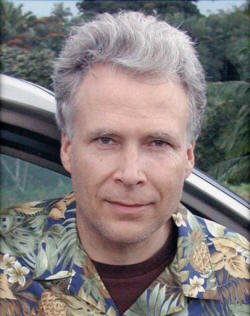 Solar Cookers International (SCI) recently inducted volunteer Tom Sponheim into
its Order of Excellence. He is the seventh to earn this honor, which recognizes
those whose "sustained efforts have contributed most to empowering people to
cook food and pasteurize water with solar energy."
Solar Cookers International (SCI) recently inducted volunteer Tom Sponheim into
its Order of Excellence. He is the seventh to earn this honor, which recognizes
those whose "sustained efforts have contributed most to empowering people to
cook food and pasteurize water with solar energy."
Tom Sponheim has been an active volunteer in solar cooker promotion for nearly 15 years. Early on, he founded and led Solar Box Cookers Northwest (SBCN), an all-volunteer organization based in Seattle, Washington (USA) promoting solar cooking and information exchange. Its excellent newsletter the Solar Box Journal eventually merged with SCI's newsletter to become the Solar Cooker Review. In 1996 Tom urged SCI to begin using the Internet as a tool for information exchange. He created and continues to serve as Webmaster of SCI's first web site, the Solar Cooking Archive (http://solarcooking.org). To date the site has been visited over 1.25 million times, and is considered the most comprehensive solar cooking web site in existence.
Thanks, Tom, for your tireless dedication to improving people's lives through solar cooking education. The entire world of solar cooking promoters is grateful to you.
New product alert: AquaPak now available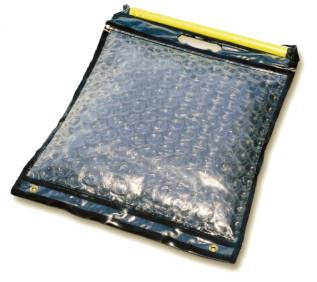
Solar Cookers International is now selling the "AquaPak" solar water pasteurizer produced by Solar Solutions, of San Diego, California, USA. This simple, unique device allows for solar pasteurization of four to five liters of water at a time, up to 15 liters per day. Weighing only six ounces when empty, the AquaPak is quite portable. Its dark, heat-generating bottom side is made from the same polyethylene plastic as food preparation boiling bags, with the addition of ultraviolet radiation inhibitors that extend the life of the plastic. Its transparent, insulating side is made of air-filled bubble pack sheeting. The AquaPak is easy to use: simply fill it with water and lay it on a relatively flat surface exposed to the sun. A built-in water pasteurization indicator (WAPI) contains wax that melts when the water is heated to 67ºC, often in two hours or less. (Pasteurization of water occurs at approximately 65ºC.) Independent laboratory tests determined that, when used properly, the AquaPak kills over 99.99% of pathogens present. An included filter may be used for water that contains sediment. The AquaPak sells for $20, plus sales tax and shipping charges as applicable. Click here for more info and purchase information.
Updated "How to" booklet completed
 Solar
Cookers International has updated and expanded its most popular publication―How
to make, use and enjoy solar cookers―with more detailed instructions and
improved graphics. This 10th edition is 52 pages long and boasts dozens of
illustrations. It provides detailed instructions for building and using both
panel-style solar cookers ("CooKits") and box-style solar cookers from simple
materials like cardboard and aluminum foil. It includes how solar cookers work,
non-cooking uses for solar cookers, ideas for teachers and an expanded solar
recipes and tips section. It sells for $7, plus sales tax and shipping charges
as applicable. This manual is downloadable from here.
Solar
Cookers International has updated and expanded its most popular publication―How
to make, use and enjoy solar cookers―with more detailed instructions and
improved graphics. This 10th edition is 52 pages long and boasts dozens of
illustrations. It provides detailed instructions for building and using both
panel-style solar cookers ("CooKits") and box-style solar cookers from simple
materials like cardboard and aluminum foil. It includes how solar cookers work,
non-cooking uses for solar cookers, ideas for teachers and an expanded solar
recipes and tips section. It sells for $7, plus sales tax and shipping charges
as applicable. This manual is downloadable from here.
A worldwide solar cooking movement, part two
By Ramón Coyle, SCI Information Exchange Specialist
Editor's note: In the July 2004 Solar Cooker Review, Mr. Coyle reported on initial results of Solar Cookers International's 2003 survey of solar cooking promoters. Here is the conclusion of his report, including information from an additional 116 respondents.
By August 2004 Solar Cookers International (SCI) had received 350 responses to its world survey of solar cooking promoters. Ninety-six countries are represented. Many thanks to all who participated. The information gathered from this survey helped us to better understand the amount and scope of independent solar cooking promotion worldwide, and provided us with current information for SCI's International Directory of Solar Cooking Promoters, accessible on the Internet at http://solarcooking.org/directory.asp.
Two hundred responders estimated how many solar cookers exist because of their efforts. Their collective estimate was 247,801 cookers, or about 1,200 per responder. Some of these cookers may have been counted twice, due to efforts of more than one promoter or promotion group. However, some 40,000 solar cookers distributed by SCI to refugees or sold to consumers are not included in the survey figures.
One hundred forty-two promoters estimated the number of cookers being used regularly. Of the 117,144 cookers these promoters are responsible for, roughly 66,000 are used regularly.
Collectively, 68 responders trained 4,045 solar cooking teachers.
The survey was not free of bias. It could only be sent to those promoters SCI was aware of, and responders may or may not be representative of the total. Because SCI has few contacts in China, we only received two survey responses from there, despite the fact that China is one of the two world leaders, along with India, in solar cooking promotion. India, where SCI co-sponsored its third international solar cooking conference, provided 25 survey responses. These 25 responders are responsible for 88,380―or about one-third―of the total cookers estimated in the survey responses.
Two survey questions examined types of solar cookers being promoted. The responses that allowed for easy categorization indicated the following:
- 85 promote box cookers exclusively
- 16 promote curved concentrator ("parabolic") cookers exclusively
- 13 promote panel cookers, like SCI's CooKit, exclusively
- 41 promote box cookers and either parabolic or panel cookers
- 12 promote box, parabolic and panel cookers
- 11 promote large capacity institutional cookers―primarily Scheffler reflector systems, and usually in conjunction with other types of cookers
Most survey responders promote one or more of these types of solar cookers: box, panel and curved concentrator ("parabolic")
In addition to mentioning Scheffler's famous giant reflectors by name, the most frequently referenced "brand names" were Group ULOG's box cookers, Sun Ovens International's box cookers, Kerr-Cole box cookers, EG-Solar's parabolic cookers and SCI's panel cookers (CooKits). Box cookers from the Solar Oven Society and the Sunstove(r) organization were each mentioned a few times as well.
Of the 18 responders who distributed over 1,000 cookers, five promote box cookers exclusively, four promote panel cookers, and one promotes parabolic cookers. Four others promote both box and parabolic cookers, and the remaining four promote panel cookers and either box cookers, parabolic cookers, or both.
Ninety-one respondents in 36 countries indicated that they sell solar cookers. These 91 respondents account for 174,348―well over half―of all the cookers produced. It is not safe to assume, however, that because these groups reported selling some cookers that all 174,348 were distributed through sales as opposed to other distribution arrangements.
Mr. Wolfgang Scheffler, who designed the large community cooking systems referred to above, deserves special mention. He reports that by early 2004, 750 of his systems had been installed worldwide by various organizations. Since these systems can cook hundreds, thousands, and, in a few cases, tens of thousands of meals per day, the distribution of 750 of these systems is a remarkable achievement.
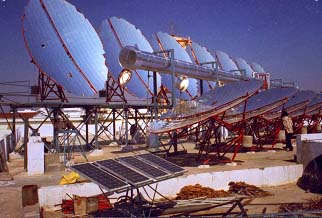
Large community cooking systems, like this one, use a series of Mr. Scheffler's reflectors to create steam that is used to cook thousands of meals.
While no scientifically verifiable conclusions can be drawn from these results, I have developed a few impressions.
First, perseverance does pay off. The promoters responsible for distributing more than 1,000 solar cookers average about 15 years in solar cooker promotion.
Second, there are still a wide variety of cooker types being promoted, lending support to the theory that different types of solar cookers are needed to fill a variety of socio-economic niches and climate conditions.
Third, the fact that over one-third of the promoters promote more than one type of cooker may indicate that solar cooker promoters have a tendency to be open to new ideas, to swap ideas, and to do what works.
Fourth, the solar cooking pioneers of 20 years ago have succeeded in moving solar cooking from the realm of interesting concept to practical reality, though still on a relatively small scale. Whereas energy principles used in solar cooking have been experimented with since the ancient Greek civilization, only in the past few decades has solar cooking leaped out of the laboratory and into the hands of the people - with promoters in 98 countries and with over 30 countries in the world boasting a minimum of 200 cookers or more each.
Fifth, is the impression that, apart from the special cases of China and India, most of the promoters who have fostered development of 500 or more cookers are involved in various kinds of international partnerships. Typically, one or more sources of funding and technical expertise from the developed countries are joined with local activists, teaching and promotion groups in developing countries.
Solid foundation of knowledge, but gaps to fill
By Kevin Porter, SCI Education Resources Director
Last year Solar Cookers International (SCI) sent out a survey to thousands of solar cooking promoters around the world. The first section of the survey was used to collect general information about the recipients, and specific information about their solar cooking activities. (See "A worldwide solar cooking movement, part two")
The second section of the survey went out to a much smaller, more targeted group of solar cooking promoters around the world, and contained questions about the informational needs and resources of the solar cooking community. The survey recipients were provided a list of solar cooking topics―organized within larger informational categories―and asked which topics they have researched and whether or not they have found useful information (either from SCI or from other sources). Next, they were asked to rank the ten topics they could most use more information about. Finally, they were asked to rank the usefulness of SCI's various educational resources.
In ranking usefulness of SCI's resources, 29% of the respondents indicated that SCI periodicals―mainly the Solar Cooker Review and SuNews―are the most useful resources. SCI's publications are considered the next most useful resource, with 20% of the votes, followed closely by SCI's Web sites (http://solarcooking.org and www.solarcookers.org) at 18% and SCI staff at 16%. SCI-sponsored conferences garnered 9% of the votes, while the SCI-sponsored e-mail discussion group rounded out the list at 7%.
The following graph provides a summary of the 76 responses we received to the second section of the survey. (Keep in mind that these sections were sent to a select group of solar cooking promoters and may or may not be an accurate representation of the larger solar cooking community.)
It is no surprise that the most researched topic―at 86% of the respondents―was solar cooking instructions. The next most researched topics were solar cooker types/ designs/ plans, at 84%, and solar cooker costs/ fuel costs, at 83%. Solar cooker business development topics were generally the least researched.
The difference between the percentage of respondents that researched a topic, and the percentage that found useful information, can be interpreted as the "information gap." The largest information gap was for the topic of influencing decision makers, with 32% of respondents not finding information they sought. Twenty-seven percent were unable to find information on publicity/ media, while 26% were unable to find information on funding strategies for project development.
The topics ranked as most in need of more information were solar cooker types/ designs/ plans, with 33% of the respondents ranking it in their top ten, followed by solar cooking health/ safety issues and trainings/ workshops, both with 25% of the respondents ranking them in their top ten.
In an effort to objectively rank the topics most needing more information I gave equal weight to A) the sheer number of respondents that researched a given topic, B) the "information gap" and C) the ranking, as submitted by the respondents, of the topics most needing further information. Using this system, here is a list of the top ten topics most needing further information:
- Cooker types/ designs/ plans
- Solar cooking health and safety issues
- Trainings/ workshops
- Funding sources for project development
- Publicity/ media
- Influencing decision makers
- Solar cooking environmental benefits
- Cooker costs/ fuel costs
- Complimentary technologies (i.e. solar food dryers, retained-heat cookers, etc.)
- Changes in daily routines/habits (due to the use of solar cookers vs. traditional cooking methods)
These findings will influence, to a certain degree, what topics SCI seeks to learn more and publish more about in the coming years. In addition, we have file cabinets full of solar cooking information that we will begin to make available digitally over the next couple of years, and these findings will help us to prioritize our schedule of document conversion.
Perhaps this information will also help you―the solar cooking community―better understand what the gaps in information are and what role you can play to help reduce these gaps. Many thanks to all of you who participated in the survey.
Secure the spread, giving appreciated
Donating stocks, bonds and appreciated securities to Solar Cookers International (SCI) helps accelerate the spread of solar cooking. One recent gift, valued at $43,000, is doing just that. It's easy and there are many tax benefits!
Your donation can be transferred to:
AG Edwards
Tel: (800) 998-0832
Solar Cookers International
Account #726-027056
DTC #0201
Please inform us of the transfer so that we may accurately identify and acknowledge your gift. For more information about making gifts of all kinds to SCI, please give me a call: (916) 455-4499.
Thank you!
Virginia Callaghan, SCI Development Director
SCI received nearly $500 from artists at the Bellevue Festival of the Arts, an annual arts and crafts fair held in Bellevue, Washington, USA. The fair is produced and sponsored by the Craft Cooperative of the Northwest (CCNW), a nonprofit cooperative working with local artists and businesses to raise funds for local, national and international causes. Nearly 250,000 people attend the festival each year. Thank you, artists, for your kind support. It is most appreciated!
Camp Kirkapresqua, a church environmental day camp in Missouri, USA, raises funds each year for causes that have to do with "peacemaking or earth keeping." This year, Solar Cookers International (SCI) was the proud beneficiary. The sixth-grade campers researched and wrote articles about solar cooking and SCI, and compiled the articles into daily newsletters that were sent home with the campers. They also built their own solar box cooker and tested it by melting cheese on nacho chips. The campers and their families contributed over $400 in support of SCI's solar cooking efforts. Thanks to all the campers and their families for their hard work and kind hearts.
Insight from Vietnam's Solar Serve organization
Editor's note: Nguyen Tan Bich, through his organization Solar Serve, has been building and promoting solar cookers in and around Ðà Nang, Vietnam since 2001. Here are excerpts from the current issue of Solar Serve's newsletter Ðà Nang Gateway News.
On the potential of solar cooking in Thailand:
During a conference in Thailand we experienced a lot of interest in solar cooking. Even Thai government officials were excited and asked questions like, "Why is solar cooking not established in Thailand yet?" There is a whole field open to provide solar cookers in all provinces in this country. We felt overwhelmed and also helpless because we are not able to respond to this request. If there were only a few people in Thailand who had a vision for solar cooking, a whole country lies open for them. There is a need for solar workers!
On the inconspicuous power of solar box cookers ...:
We decided to celebrate International Day of Environment (June 5th) with a solar cooking demonstration in front of a People's Committee building in Bình Minh village. Our staff asked 50 participants of our solar cooking course to cook with their newly provided solar box cookers. We also added five parabolic solar cookers for frying. It was a whole day of setting up, going to the market, preparing the dishes for cooking, waiting and eating.
In the beginning the parabolic solar cookers caught a lot of attention when people could see and smell the cooked food, while the solar box cookers were just sitting in the sun without any excitement. It was the first time that we used the parabolic cookers in public and people were standing in disbelieve when a piece of paper burned in 30 seconds. When we opened the 50 solar box cookers, however, people changed their minds, because they were able to see and smell the cooked dishes in these cookers too. After we ate with 100 people―young and old―there was no doubt anymore that it was possible to cook with the sun.
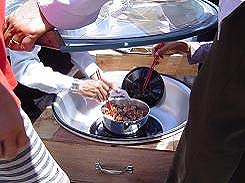
When we opened the 50 solar box cookers, however, people changed their minds"
... and the conspicuous powers of good publicity:
A few days before Environment Day a film crew passed our house while Solar Serve staff members were solar cooking. This was so new for them that they made a short film and a few days later we were on local and national television. Free advertisement! Later, we transferred 30 solar cookers to the mountains near Ðà N?ng to help the Katu, an ethnic minority group. The people were very simple and friendly and loved cooking with the sun. While we were teaching them another film crew was making a documentary about the Katu working in the field. When the film crew found the Katu were solar cooking, they became so excited and decided to make a documentary about this "new" idea. It will be shown on Ðà N?ng television soon. It helped our staff to understand that what they are doing is very valuable. Sometimes people look down on them because solar cookers are not high-tech. Vietnam is a poor country and people think that high technology shows development. But we know better! The adoption of solar energy will help people a lot and even the environment will improve.
On grasping opportunities:
After a few days working with the Katu people, two staff members came down to Ðà N?ng. Solar Serve was hosting a group of volunteers working in Vietnam. We cooked a solar lunch on the beach, and it was good for them to see our newly-made parabolic solar cookers. We have made 10 of them.
When we finished our solar lunch a professor from a University of Sweden saw our staff putting the cookers away. He was a guest in the hotel but works for the ministry of agriculture in Hanoi. He became very excited when he saw the cookers. He made it very clear to us that he wanted to use them in the North for his project. If it works well he will contact us for further co-operation. We had already made a purpose for those cookers, but we decided to help the professor. The next day he had already arranged transport. He was very thankful and called and mailed us a few days later to thank us again. Our staff was very excited that a foreigner, who works with the Vietnamese government, appreciated the cookers. We hope we can serve more people in Vietnam like this.
Solar cooking takes off in Rae Girls Secondary School
By Dinah Chienjo, SCI Sunny Solutions Project Officer
Editors note: We receive many positive anecdotes about the impact of solar cooking on the lives of women and families in our "Sunny Solutions" project in Nyakach, Kenya. Sometimes these stories describe initial struggles with solar cooking, but ultimate triumph due to the talent and persistence of Solar Cooker Representatives (SCOREPS), who work in conjunction with Solar Cookers International (SCI) to promote solar cooking and sell solar cookers in Nyakach. There are currently 15 SCOREPS working in Nyakach.
This story is a tribute to the efforts of Jesca, one of those SCOREPS.
SCOREP Jesca shows off her solar CooKit
Ms. Jennifer Okoth, a clerk at Rae Girls Secondary School, acquired her first CooKit in March 2004. Her initial trials on solar cooking were not very successful, yet after training and support from SCOREP Jesca, she acquired skills in solar cooking. By mid-May 2004 Ms. Okoth had facilitated the sale of three more CooKits to her colleagues.
"Jennifer is very influential," say her colleagues. "She has made solar cooking to dominate discussions amongst members of staff in the school. Whenever she bakes bread or cake she calls all neighbors to have a taste. As a result, about 10 CooKits have been sold in the school. Her enthusiasm has made the school a solar cooking zone."
Ms. Okoth writes, "An impromptu spot check of the school reveals that on any sunny day seven or eight out of 10 households solar cook. When you get to the school gate, the guards will tell you about solar cooking. Almost all staff members residing at the school have bought CooKits and about five members of staff have bought second CooKits."
Ms. Okoth has two CooKits. She has started paying for a third one for her mother. (CooKits in Nyakach retail for around $7 each.)
Ms. Okoth continues, "It is common to find foods cooking outside while the teachers attend classes. Any time you visit the school every user is eager to give you a lesson or two on solar cooking. They are discovering new recipes on their own. They actually compete on who bakes the best bread or cake."
Tribute gifts have been given to SCI by:
- Linda and Gerald Hayward in memory of Linda's mother, Genevieve Malmstrom
- Bev Blum in memory of Genevieve Malmstrom
- Joseph R. Heller in memory of Esther N. Heller
- Joe McCabe and Cindy Erickson in memory of Roy Barnes
- Grace Presbyterian Church in honor of Jim and Pat Dowrie
- Jan Hansen in honor or Eve Davidson
- Catherine R. Mumaw in honor of Ed and Kathleen Heath, on the occasion of their 50th wedding anniversary
- Catherine R. Mumaw in honor of Oris and Lois Basinger, on the occasion of their 50th wedding anniversary
- Gwynne P. Smith in memory of her parents, George and Gertrude Prosser
Pilot project in Afghanistan confirms need; expanded project recommended
By Gordon Magney, Project Director
Editor's note: This project was supported by a number of individuals and organizations, including Mark Sandin and other friends at Lakewood EF Church, Mike and Martha Port of the Solar Oven Society, Dan Batchelder, and Global Hope Network International. The project manager was Hamidullah. Several international nongovernmental organizations (NGOs) assisted with distribution of the solar cookers, including CARE, Shelter for Life and Global Partners.
This article has been edited for length and clarity. The "SOS Sport" solar cooker used in this project is available through Solar Cookers International. See order form on the inside back cover for more details.
Why solar cookers in Afghanistan?
Affordable, non-polluting cooking fuel is a serious need in Afghanistan. The most common cooking fuel is firewood. Free firewood is no longer available to many Afghan families since most of the forests have been destroyed by the war, years of drought, and goats. Even where sticks, branches or bushes can be collected from the fields, the chance of being injured by landmines when gathering them is high.
Firewood costs $0.08 per kilogram in Kabul and $10 a donkey-load in Faizabad. Kerosene costs $0.39 per liter. Electricity is not available in much of Kabul or most other parts of the country. It is estimated that the average family burns four to seven kilograms of firewood daily for cooking. In that case they will spend $10 to $17 a month on fuel. This is a heavy burden for many who only earn $30 a month (a teacher's salary) and the many who are unemployed.
The country enjoys a sunny climate, though, so conditions for using solar energy for cooking food and boiling water are quite ideal. Afghanistan averages 300 solar cooking days a year. Even in the winter months, many days have clear skies and solar cooking can be done.
In addition to saving money, solar cookers reduce the amount of smoke in the lady's eyes and lungs. Air pollution is reduced whenever solar cookers are used instead of wood or fossil fuels.
Many Afghans became aware of solar cooking when they were refugees in Pakistan in the early 1980s. There, a nongovernmental organization (NGO) called Serving Emergency Relief and Vocational Enterprises (SERVE) produced and distributed solar ovens to thousands of families. In a nine-month pilot project, over 80% of those with solar ovens used them when possible. SERVE also distributed many solar ovens inside Afghanistan in the 1990s. By 2001, when the project ended, more than 20,000 solar ovens had been distributed by SERVE to Afghans. A second NGO―Agency for Rehabilitation and Energy Conservation in Afghanistan (AREA)―began in 1993 to produce and distribute parabolic solar cookers in Herat and other parts of Afghanistan. These are sold without subsidies through village cooperatives on time payment. AREA has produced and distributed more than 2,500 units in various parts of the country.
Project objectives
- Promote the use of solar energy in Afghanistan
- Provide affordable solar ovens to 400 families
- Teach solar cooking to those who buy the ovens
- Employ and train Afghans to assemble, repair and distribute solar ovens
Method
We chose to import the "SOS Sport" solar oven instead of making them locally because the imported ovens were cheaper, lighter and more attractive than those made in Afghanistan. The SOS ovens are made by the Solar Oven Society, a US-based NGO that helps developing countries have access to inexpensive solar ovens.
Four hundred solar ovens were ordered, with donated funds, and shipped to Afghanistan in January 2003.
The ovens came unassembled in a container along with cartons of blankets for relief distribution. Two engineers came from Singapore for a month to help assemble and train several Afghans how to put together the ovens. The ovens came with thermometers and Water Pasteurizing Indicators (WAPIs) but without cooking pots or oven mitts. We designed and ordered 800 cooking pots from Pakistan and coated the outsides with blackboard paint. We also ordered 800 oven mitts to be made locally and given with the ovens. To shorten cooking times we made 400 reflectors and gave them out with the ovens.
The people who most need solar cookers are usually those who cannot afford to buy them, at full price anyway. We therefore offered the cookers at a subsidized price of $15. This amount is enough to indicate a true interest in solar cooking. Before selling the solar cookers we demonstrated how they worked by solar cooking various foods and giving out samples. During the two or three hours that the food cooked, the team would explain the various benefits of using solar energy and answer questions. Solar ovens were sold in Kabul, as well as places like Maidan, Faizabad, Yakalang, Mazar and Istalif.
Results
Solar cookers sold briskly. For example, all 29 ovens sent to Yakalang were sold in one morning during the first cooking demonstration. In another example, four cookers were taken to Faizabad and demonstrated in two government schools. So many teachers ordered cookers that 90 ovens were shipped there and distributed.
Mixing solar cake batter at the CARE office in Kabul, with SOS Sport ovens in the background
After families had a chance to use the cookers for some time we collected feedback and found they were using them whenever the sun shone. Several men bought a second oven since they had large families. They used the ovens to cook bread, cake, rice, vegetables, meat, beans, potatoes and chicken.
When asked if the cookers saved money for the family, one lady replied that the amount of firewood that previously lasted three days now lasts one week. Most of the families indicated a savings of half their cooking fuel bill from using solar cookers. Also, solar cooks spent less time and energy gathering firewood.
Those who showed the most interest were from low- and middle-income families. The very poor cannot afford the cooker and those who are well off can easily pay for fossil fuels.
A handful of technical issues with the ovens were discovered over the course of the project. The manufacturer has since addressed those issues.
Conclusion and recommendations
The pilot project demonstrated that the SOS Sport is very suited for the people of Afghanistan. Many folks were amazed that such a lightweight, easy to operate solar cooker could cook delicious food in only two to three hours. We could easily have sold many more if we had them.
We recommend that a larger number of cookers be imported in the near future and distributed in areas where cooking fuel is very scarce, including Badkhshan, Hazarajat, Kundus, Ghor and Balkh. The cookers should be assembled in the same areas where they will be distributed to save shipping costs and reduce the chance of damage caused by transport.
Contact Global Hope Network International, PO Box 3023, Share Nau, Kabul, Afghanistan
Solar Cooker Review
Solar Cooker Review is published two or three times per year with the purpose of presenting solar cooking information from around the world. Topics include solar cooker technology, dissemination strategies, educational materials, and cultural and social adaptations. From time to time we cover related topics such as women’s issues, wood shortages, health, nutrition, air pollution, climatic changes, and the environment.
Solar Cooker Review is sent to those who contribute money or news about solar cooking projects. The suggested subscription price is US $10/year. Single copies are sent free to select libraries and groups overseas.
We welcome reports and commentary related to solar cooking for possible inclusion. These may be edited for clarity or space. Please cite sources whenever possible. We will credit your contribution. Send contributions to Solar Cookers International, 1919 21st Street, Suite 101, Sacramento, California 95811-6827, USA. You may also send them by fax: (916) 455-4498 or e-mail: info@solarcookers.org.
Solar Cooker Review is compiled and edited by the staff of Solar Cookers International (SCI), with layout graciously provided by IMPACT Publications located in Medford, Oregon, USA.
Back issues are available at http://solarcooking.org/docs.htm#backissues.
SCI is a 501(c)(3) nonprofit organization assisting communities to use the power of the sun to cook food and pasteurize water for the benefit of people and environments. We do not sell, rent or trade names of our donors. Tax ID # 68-0153141.
